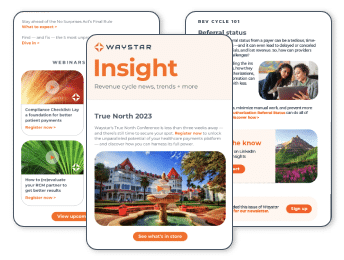Federally Qualified Health Centers (FQHCs) face unique challenges — such as lack of resources, limited funding and disparate workflows — which can inhibit the ability to get paid faster and more accurately.
Leveraging technology and a partner with revenue cycle expertise can help your FQHC reduce denials, administrative burdens and manual workflows to maximize reimbursements. Below, we’re taking a look at five strategies you can start implementing today to help achieve those goals.
1. GOAL: Capture potential reimbursement
Strategy: Prioritize + prevent denials with automation
Health centers often rank denial management as one of their greatest challenges within the revenue cycle. Without the right tools, managing denials and compiling appeal packages can slow cash flow and take your team away from higher-value tasks. No two denials are the same, and your team needs to submit appeals quickly and efficiently. Here’s how you can use stronger automated solutions to prioritize and prevent denials.
- Reduce avoidable write-offs by using root-cause reporting to address upstream drivers of denials.
- Improve your workflow with simplified tools, allowing you to prioritize the right denials with the right resources.
- Use measurable KPIs to assess staff productivity and effectiveness.
- Eliminate the paper appeals process to accelerate appeal submissions and tracking.
- Automate and simplify your denials and appeals, allowing you to capture all potential reimbursement.
2. GOAL: Reduce eligibility-related denials
Strategy: Find hidden coverage + empower patients with stronger eligibility tech
If you’re like most health centers, your patient engagement staff probably spends a serious amount of time verifying eligibility and benefit details. Despite all this effort, more than half of denials are attributed to front-end processes. How can you combat these challenges?
- Encourage informative patient financial conversations and boost patient satisfaction with real-time, multi-payer eligibility to find accurate patient coverage details.
- Engage and empower your patients by keeping them informed and educating them on their benefits and options.
- Utilize intuitive cloud-based technology and easy-to-use tools to create a simple user workflow.
- Use advanced tools to identify any active coverage on self-pay patients where it may otherwise be unknown.
3. GOAL: Increase cash flow
Strategy: Accelerate reimbursement with precision, accuracy + visibility
Claim management is one of the most demanding parts of the revenue cycle due to deep-rooted manual processes, a lack of visibility into payer data and other challenges. Collecting from patients is another significant challenge, as more financial responsibility falls on them.
It is critical to implement the right tools and resources across your entire revenue cycle to help prevent rejections and denials before they happen, automate claim monitoring, streamline appeals and attachments, utilize multiple patient payment methods and work both commercial and government claims in one place.
How can you improve your clean claims rate?
- Start at the beginning. Check eligibility on every patient and utilize a solution that will ensure you get the most accurate responses. Cash flow improvement requires a different perspective. Your patient engagement staff holds the keys to preventing the most frequent cause of denials.
- Use a claim-scrubbing engine that will flag errors before the claim is ever submitted to the payer to avoid delays in payments.
- Automate your claims status activities — don’t waste valuable time by calling payers or going to their websites to search for those details.
- Stop hunting down information and avoid the pitfalls of process inefficiency. A focus on process improvement and automation can mean the difference between a write-off versus a timely appeal and payment.
- Understand your denials, then plan your staffing. Triage and correctly route denials for optimal prioritization and staff specialization.
- Automate your appeals process and go paperless. Eliminate manual processes with auto-populated data and attachments with payer-specific forms.
- Use comparative analytics to track your progress and measure your success against other health centers like you.
4. GOAL: Boost productivity
Strategy: Streamline workflows + do more with less
The complexities of revenue cycle management can be challenging enough without worrying about multiple vendors supporting each step in the process. Disparate workflows can cause staff inefficiencies and unforeseen delays, making it difficult to accomplish tasks in a timely manner. The ability to process commercial, government and dental claims in one place can dramatically increase productivity across the board. Here are some ways you can increase productivity.
- Choose a platform that allows you to do more with less effort.
- Transform your workflows by consolidating your claims submission processes through one vendor and one connection.
- Allocate your resources in new ways with tools that simplify your team’s tasks and activities.
5. GOAL: Reduce Medicare AR days + get paid faster
Strategy: Automate Medicare claim management
Medicare claims add up to a sizeable payer mix that can significantly influence the financial health of your organization, but they pose their challenges. Submission through your clearinghouse or direct data entry is inefficient. Manual claim editing processes are error-prone. A lack of transparency into returned, denied or pended claims can also put you at risk of violating timely filing rules.
There is no better reason to explore ways to automate workflows, achieve Medicare compliance and ultimately get paid more quickly. Reduce Medicare AR days to get paid faster with these tips. Implement your Medicare tools, workflows and analytics in one place — no more direct data entry or manual processes.
- Choose a partner who can offer direct access to Medicare’s FISS system.
- Implement compliance solutions that help you expedite documentation submissions.
- Ensure you have the right resources in place to avoid duplicate claim submissions and reduce AR days.
Wrapping it up: Planning for success starts with the right strategy
Between staff and resource limitations, FQHCs face unique challenges as you strive to fill a critical role in your communities. That’s why automation and visibility are vital to success, not just in day-to-day operations, but in pursuit of the greater mission to enrich patients’ lives.
Are you looking to fully transform your FQHC’s revenue cycle with a new approach? Waystar helps you achieve your goals with strategies to:
- Capture all potential reimbursement
- Reduce eligibility-related denials
- Increase cash flow
- Boost productivity
- Reduce Medicare AR days + get paid faster
Want to know more? Learn how Waystar tailors solutions to help FQHCs reduce denials, accelerate reimbursement and elevate their patient experience.
Find this post helpful? Read Compassionate communication: boost patient loyalty + payments by going back to the basics.


